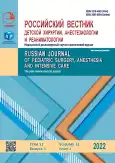Situs inversus totalis in combination with hiatal hernia and hereditary hemolytic anemia in a 4-year-old child: A case report
- 作者: Sharipov A.M.1,2,3, Mukhiddinov N.D.4, Rahmatova R.A.1,2, Mazabshoev S.A.1,2
-
隶属关系:
- Avicenna Tajik State Medical University
- National Medical Center “Shifobakhsh”
- Institute of Postgraduate Education in Health Service
- Republican Scientific Clinical Center of Pediatrics and Pediatric Surgery
- 期: 卷 12, 编号 3 (2022)
- 页面: 383-390
- 栏目: Case reports
- URL: https://journals.rcsi.science/2219-4061/article/view/123642
- DOI: https://doi.org/10.17816/psaic1037
- ID: 123642
如何引用文章
全文:
详细
Situs inversus totalis is an extremely rare anomaly in which the organs of the chest and abdominal cavity lie in the opposite direction. With complete transposition, clinical manifestations may be absent, and diagnostic and therapeutic problems may arise in the presence of other malformations or diseases.
A 4-year-old girl was admitted for treatment in the hematology department of the National Medical Center of the Republic of Tajikistan, with complaints of nausea, periodic vomiting, lethargy, lack of appetite, malaise, and skin pallor. Owing to the ineffectiveness of conservative therapy, surgical treatment was recommended, i.e., splenectomy. During the preoperative examination, radiography and radiopaque examination of the organs of the gastrointestinal tract with barium sulfate revealed that the fundus and body of the stomach were located in the left half of the chest, and the heart was symmetrically deployed to the right. An ultrasound examination revealed signs of displacement of the liver to the left half of the abdomen, the spleen to the right, and the heart in the right half of the chest. The diagnosis was “hiatal hernia on the left, situs inversus totalis, hereditary hemolytic anemia, fermentopathy, and G-6-PD deficiency.” Laparoscopic surgery was performed, which included splenectomy, elimination of a hiatal hernia, chiatoplasty, and esophagogastrofundoplication with the creation of a Nissen cuff. The girl was discharged on day 10. On control examination after 6 and 12 months, she had no complaints and has grown and developed according to age.
This clinical case is the first in the Russian literature to describe the treatment of a child with a hiatal hernia against the background of complete transposition of internal organs. This case highlights the need for imaging techniques for any unclear symptoms, especially in children with hereditary diseases. Minimally invasive intervention could contribute to a favorable outcome.
作者简介
Aslamhon Sharipov
Avicenna Tajik State Medical University; National Medical Center “Shifobakhsh”; Institute of Postgraduate Education in Health Service
编辑信件的主要联系方式.
Email: aslam72@list.ru
ORCID iD: 0000-0002-3534-9208
SPIN 代码: 3072-5037
Dr. Sci. (Med.), Head of Pediatric Surgery Department
塔吉克斯坦, Dushanbe; Dushanbe; DushanbeNuriddin Mukhiddinov
Republican Scientific Clinical Center of Pediatrics and Pediatric Surgery
Email: nuridd@mail.ru
Dr. Sci. (Med.), Rector
塔吉克斯坦, DushanbeRukhshona Rahmatova
Avicenna Tajik State Medical University; National Medical Center “Shifobakhsh”
Email: ruhsh6868@mail.ru
ORCID iD: 0000-0003-1333-5427
Dr. Sci. (Med.), Head of the Department of pediatric anesthesiology, resuscitation and intensive care
塔吉克斯坦, Dushanbe; DushanbeSalomatsho Mazabshoev
Avicenna Tajik State Medical University; National Medical Center “Shifobakhsh”
Email: samicdoctor@mail.ru
ORCID iD: 0000-0002-9346-0764
SPIN 代码: 6678-2908
MD, Cand. Sci. (Med.), anesthesiologist-resusitator
塔吉克斯坦, Dushanbe; Dushanbe参考
- Casey B. Genetics of human situs abnormalities. Am J Med Genet. 2001;101(4):356–358. doi: 10.1002/ajmg.1220
- Sutherland MJ, Ware SM. Disorders of left-right asymmetry: heterotaxy and situs inversus. Am J Med Genet C Semin Med Genet. 2009;151C(4):307–317. doi: 10.1002/ajmg.c.30228
- Fonkalsrud EW, Tompkins R, Clatworthy HW. Abdominal manifestations of situs inversus in infants and children. Arch Surg. 1966;92(5):791–795. doi: 10.1001/archsurg.1966.01320230139025
- Poroki razvitiya diafragmy In: Neonatal’naya khirurgiya. Yu.F. Isakov, N.N. Volodin, A.V. Geraskin, eds. Moscow: Dinastiya; 2011. P. 332–358.
- McGivern MR, Best KE, Rankin J, et al. Epidemiology of congenital diaphragmatic hernia in Europe: a register-based study. Arch Dis Child Fetal Neonatal Ed. 2015;100(2):F137–F144. doi: 10.1136/archdischild-2014-306174
- Tesselaar CD, Postema RR, van Dooren MF, et al. Congenital diaphragmatic hernia and situs inversus totalis. Pediatrics. 2004;113(3):e256–e258. doi: 10.1542/peds.113.3.e256
- Romeo C, Turiaco N, Gitto E, et al. Right bochdalek hernia associated with kartagener syndrome: developmental and clinical observations. European J Pediatr Surg Rep. 2013;1(1):15–17. doi: 10.1055/s-0033-1343077
- Patel RV, Jackson P, De Coppi P, et al. Laparoscopic Nissen fundoplication and gastrostomy for a giant hiatal hernia in an infant with situs inversus totalis. BMJ Case Rep. 2014;2014:bcr2013202764. doi: 10.1136/bcr-2013-202764
- Demidov VN, Mashinets NV, Gus A, et al. A rare case of congenital right-sided diaphragmatic hernia in combination with situs inversus in a fetus. Obstetrics and Gynecology. 2015;(6):136–139.
- Bogdanov AN, Mazurov VI. Hemolytic anemia. St Petersburg Medical Academy of Postgraduate Studies. 2011;3(3):107–114.
- Torfs CP, Curry CJ, Bateson TF, et al. A population-based study of congenital diaphragmatic hernia. Teratology. 1992;46(6):555–565. doi: 10.1002/tera.1420460605
- Heitmann F, Erdem S, Langwieder C, et al. Total laryngo-tracheo-esophageal cleft with situs inversus totalis, aplasia of the right diaphragm and hypoplasia of the lung on the right side. Z Geburtshilfe Perinatol. 1988;192(4):181–183. (In German.)
- Itoh M, Wada Y, Hashimoto U, et al. A case of intralobar pulmonary sequestration associated with ASD, dextrocardia, hypoplasia of the right lung and eventration of the diaphragm. Kyobu Geka. 1987;40(13):1099–1103.
- Yang MJ, Russell KW, Yoder BA, Fenton SJ. Congenital diaphragmatic hernia: a narrative review of controversies in neonatal management. Transl Pediatr. 2021;10(5):1432–1447. doi: 10.21037/tp-20-142
- Mandhan P, Memon A, Memon AS. Congenital hernias of the diaphragm in children. J Ayub Med Coll Abbottabad. 2007;19(2):37–41.
- Razumovsky AYu, Alkhasov AB, Bataev SМ, Ekimovskaya EV. Laparoscopic Nissen fundoplication — the gold standard for the treatment of gastroesophageal reflux in children. Experimental and Clinical Gastroenterology. 2015;1(113):72–77.
- Ru W, Wu P, Feng S, et al. Laparoscopic versus open Nissen fundoplication in children: A systematic review and meta-analysis. J Pediatr Surg. 2016;51(10):1731–1736. doi: 10.1016/j.jpedsurg.2016.07.012
- Tsung A, Feliz A, Kane TD. Laparoscopic Nissen fundoplication in an infant with situs inversus. J Laparoendosc Adv Surg Tech A. 2007;17(5):698–700. doi: 10.1089/lap.2006.0244
补充文件






